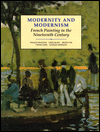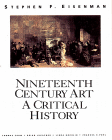|
Recommended Readings
|

Modernity and Modernism : French Painting in the Nineteenth Century
by Francis Frascina, Nigel Blake, Briony Fer, Tamar Garb, Charles Harrison
The authors seek to explain the most important issues confronting any study of modern art, without attempting exhaustive coverage. The books present a range of approaches characteristic of current art-historical debates. The first volume focuses on aspects of Realism, Impressionism and Post-Impressionism in Paris between about 1848 and 1900.
More info
Buy now
|

Nineteenth Century Art : A Critical History
by Stephen Eisenman
'This book will prove to be essential reading for all students of 19th Century art, and will help to redefine the shifting boundaries of the art-historical survey' -- The Guardian.
'It must be regarded as required reading for those interested in the roots of contemporary culture' -- American Arts Quarterly.
More info
Buy now
|

Nineteenth Century Art
by H. W. Janson, Robert Rosenblum
In this volume, Janson and Rosenblum combine their scholarship talents to supply readers with yet another definitive art history, surveying painting and sculpture between 1776 and 1900 and demonstrating the influences of technology, politics, literature, and music on the art world. All the major names are represented (David, Goya, Manet, Renoir, Van Gogh, Rodin, etc.) as well as lesser masters from Victorian eccentrics and French academics to the Belgian Social Realists.
More info
Buy now
|
|
      
|
Manet
Manet's far reaching influence on French painting and the general development of modern art was due to his portrayal of everyday subject matter; his use of broad simple colour areas; and a vivid summary brush technique. These techniques allowed Manet to flatten out the picture plane, and it became a surface rather than an illusion like the Academic paintings.
...more 
|
|
Monet and the Impressionists
Monet's Impressionist works are small, informal in composition, freely and spontaneously painted, showing everyday scenes treated in bright colour. He summarized his aim of painting in 1926: "I have always had a horror of theories, my only virtue is to have painted directly in front of nature, while trying to depict the impressions made on me by the most fleeting effects".
...more 
|
|
Degas: Odd Man Out
Degas in usually classed with the Impressionists, and he exhibited with them in seven of the eight Impressionist exhibitions. However, his training in Classical drawing and his dislike of painting directly from nature produced a style that represented a related alternative to Impressionism. Degas's early approach is contrasted to the Impressionist...
...more 
|
|
|
|
Van Gogh: 1888--1890
Van Gogh's work represents the emotional spontaneity in painting. He attempted in his paintings a totality of human experience, such experience could not be conveyed in words but which could be expressed in line, colour and brushwork. After cleaned his palette of muddy tones and insipid graduations of colour, he kept only the purest and crudest of tints, those highest in key, setting them down in abrupt but harmonious contrast.
...more 
|
|










